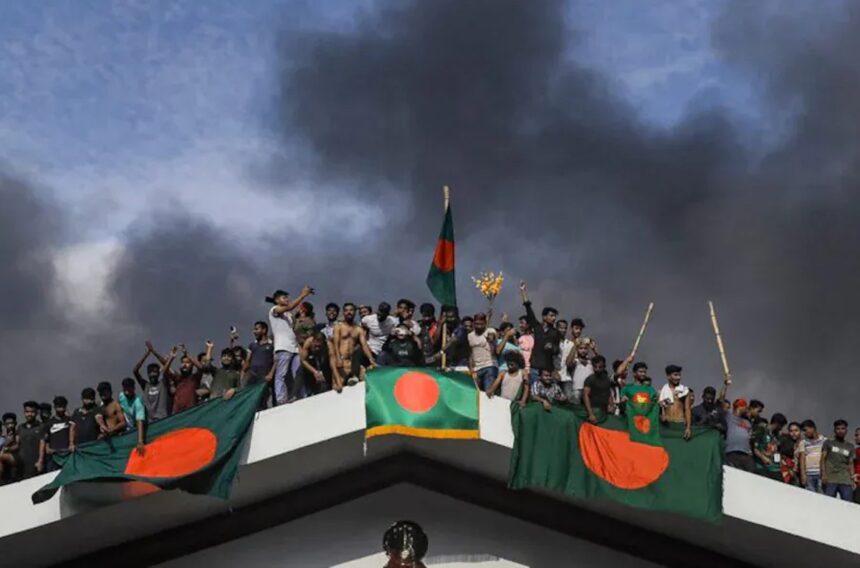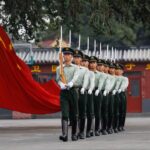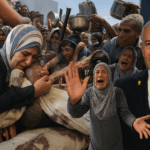The article discusses a significant political upheaval in Bangladesh, where Prime Minister Sheikh Hasina was forced to evacuate her residence due to massive student protests. The protests, initially about a new job quota system, escalated into broader discontent over high inflation and unemployment. The military refused to suppress the protests, leading to Hasina’s departure and the rise of Muhammad Yunus as interim prime minister.
It suggests that the US played a role in these events, aiming to establish a strategic naval presence in Bangladesh due to its proximity to China and its strategic location. The situation has raised concerns about potential civil war and violence against minorities in Bangladesh.
Overview:
The article explores the dynamics of political turmoil in Bangladesh, suggesting that it could have significant repercussions for neighboring India and the broader region.
Key Points:
- Current Political Climate in Bangladesh:
- Bangladesh is experiencing heightened political instability, marked by protests, political violence, and accusations of government corruption and authoritarianism.
- The ruling party, led by Prime Minister Sheikh Hasina, faces criticism for suppressing opposition and curtailing democratic freedoms.
- Potential for “Color Revolution”:
- The article draws parallels between the current situation in Bangladesh and previous “color revolutions” in other countries, where popular movements have led to significant political change.
- There are concerns that ongoing unrest could escalate into a major political upheaval, potentially leading to regime change or significant reforms.
- Impact on India:
- Bangladesh’s instability could spill over into India, given the close geographic and political ties between the two countries.
- India is concerned about the potential for increased refugee flows, cross-border violence, and regional instability affecting its security and economic interests.
- Regional and International Implications:
- The unrest in Bangladesh has implications for regional stability, potentially affecting the balance of power and security dynamics in South Asia.
- International actors, including the United States and China, are also monitoring the situation closely, as changes in Bangladesh could influence their strategic interests in the region.
- Government Response and International Reaction:
- The Bangladeshi government has taken measures to suppress dissent and maintain control, but these actions have drawn criticism from human rights organizations and the international community.
- The response from international actors, including potential diplomatic and economic pressures, could influence the course of events in Bangladesh.
Conclusion:
The article concludes that the political turmoil in Bangladesh has the potential to become a significant regional issue, with possible implications for India and broader South Asian stability. The situation warrants close attention from both regional and international stakeholders to address the challenges and mitigate potential impacts on regional security and diplomatic relations.
Read more below.
Bangladesh as color revolution on India’s doorstep
Indian intelligence agencies, rarely the epitome of self-assured success, have rarely been caught as flat-footed as they were over the weekend when Bangladesh’s Prime Minister Sheikh Hasina hurriedly evacuated her palatial residences for a rather modest government guest house on the outskirts of Delhi.
In a matter of a few hours, the former “Iron Lady” of Dhaka found her position, and perhaps prospects for her life itself, quite unviable, when the head of the armed forces (who happened to be her niece’s husband) communicated the troops’ refusal to fire at “student” protestors who were gathering in force across the country.
Adding salt to the injury, various democracies such as the United States and the United Kingdom refused or revoked her visa after the events that brought former Grameen Bank chief and Nobel prize winner Muhammad Yunus to power as interim prime minister.
Such epochal events in a country of nearly 175 million have hardly raised much more than a shrug even amidst a relatively slow (political) news cycle in August across the Western world.
Perhaps the media are more focused on the summer Olympics but clearly the events in Dhaka would assume much greater importance if violence, already targeting the country’s minority Hindus, were to spiral out of control into a full-blown civil war.
In particular, the hand of the US government is discernible in the rapid unraveling of events since the middle of June when student protests around a new job quota system of descendants of the country’s freedom struggle soon erupted into broader protests by a population that had grown increasingly sick of high inflation and high unemployment of educated young people.
In line with the toolkit used in the “Spring Revolution” countries ranging from Tunisia to Egypt, mass simultaneous protests erupted around Bangladesh with acts of violence targeting only minorities (considered closer politically to Hasina’s Awami League party).
The police and the army were called to help but proved utterly ineffective against the humongous mobs gathered. Despite various incidents of tear gassing and even shoot-at-sight orders (which were hardly carried out in practice as police preferred to fire in the air rather than at protestors directly), emboldened mobs had threatened to march on the capital this week, prompting Hasina’s ignominious exit.
Why would the US bother?
Given the country’s relatively small geographical presence that belies its population and its lack of substantial resources, the primary question for any reader would be why the US would even bother to trigger a coup in the country.
The answer lies in the country’s location, in the strategic eastern part of India with significant proximity to China. That is not all – being essentially a riparian state serviced by two of the world’s biggest rivers, the Ganges and the Brahmaputra, which together form one of the world’s most fertile deltas (explaining the population density) – the country’s ports have long attracted naval powers ranging from the British, Japanese and Russians, to more recently the Chinese and Americans at different points in time.
At the moment, the primary US interest in the country is to establish a service port for mid-size US naval vessels that could help America manage naval operation risks caused by China’s access to ports in neighboring Myanmar and offer logistic services to friendly powers in the region without needing any approval or participation from India.
To be sure, over the longer term, there is a significant strategic geopolitical advantage to be garnered from taming and managing the riparian economy of Bangladesh, with the northern parts of the country offering perfect topography for aerial incursions into the soft underbelly of China to the southeast of the Tibetan-Sichuan region, an area that China has ruled to the point of being entirely complacent about potential military risks.
An inkling of those political and military risks has come from India since the failed Doklam incursions of 2017, that has in turn triggered significant geopolitical activity around Bhutan and Nepal by the Chinese as they continued to intensify pressure on India before effectively achieving unparalleled superiority by the beginning of 2022.
With India on the back foot, the US clearly feels the need to step in – and if Delhi-based observers are to be believed, step up the ante.
So what makes it a color revolution?
Events in Bangladesh do roughly fall in line with the examples of various color revolutions in Europe and the “Spring” movements in that:
- Mass protests triggered by a specific issue that the host government would normally have considered a minor, niche item
- Active participation of multiple social groups, usually led by younger people but soon spreading across society to hitherto unpolitical groups
- Significant use of technology, in particular secure communication apps (which may or may not have been assisted by a foreign state actor to ensure encryption upgrades beyond the host country’s ability to monitor or disrupt)
- Generous and unexplained funding, usually emanating from new bank accounts of recently established charities and NGOs
- Random news designed to incite more participants and in particular the use of graphic images of rape involving young women and images or videos of authority figures causing grievous bodily harm or even dismembering human bodies.
From what this writer has reviewed as raw data over the past 72 hours, a number of these conditions have been met, although it has thus far proved impossible to corroborate or prove much of the information to the typical standards of evidence-based documentation.
What’s the background?
At just over 52-years-old, the Bangladesh that entered 2024 was a sprightly young adult in the league of nations, boasting rapid economic growth, GDP per capita that had gone past South Asian peers including India (having left fellow Muslim carve-out Pakistan in the dust many years ago), with reasonable infrastructure, public payments systems and a marked competitive edge in labor-intensive mass industries such as textiles ranging from budget garments to higher-end fashion items.
In addition, many social indicators including the participation of women in the formal economy and health metrics of average school-going children all were the envy of the region.
Anyone familiar with the country’s bloody history since the 1960s would generally be appreciative of the giant strides of the past 15 years. An attempt at democracy that led the elites of (western) Pakistan fearing rule by the “Bengalis” led to an attempted genocide that was only stopped by the timely intervention of the Indian army that helped armed local guerillas take down Pakistan armed forces in a matter of a few days in December 1971.
Since then, the echoes of political assassinations and military coups, so familiar to Pakistan watchers, have rung regularly in the parliamentary halls of Dhaka.
Ruling since 2009, Hasina had indeed become much more dictatorial and had taken extreme action against the Bangladesh National Party of her bete noire and former political partner Khaleda Zia (the two had ganged up to bring down President Ershad in 1990), along with her ongoing crackdown on fringe terrorist movements that operated under the general umbrella of the Jamaat-e-Islami (Jamaat).
Who are the players?
The formerly indifferent relationship between India and Bangladesh took a sudden turn for the better since 2014, when incoming Prime Minister Narendra Modi invited heads of other South Asian governments to his inauguration in a first for an Indian prime minister.
While his efforts to establish a more positive tone in relations with Pakistan came a cropper, Modi and Hasina did get along rather well.
After the horrifying terrorist attacks in Dhaka in July 2016 that left at least one Indian dead (a young woman who had been a tourist), India provided significant and recurring assistance on the intelligence and arms fronts to Hasina as she cracked down on the banned Jamaat networks that sometimes poured across the border into India, particularly into the welcome embrace of the opposition-led Bengal state.
Over the years, despite many provocations, the two leaders have maintained a cordial relationship that contributed to stability for the region, cooperation on anti-terrorist activities as well as a crackdown on people smuggling that had an ironic side-effect, namely to shift the activities away from India towards the “mother lode” of Europe and the United States.
It does appear, and it certainly has been actively discussed in Delhi all week, that Indian intelligence agencies simply failed to grasp the momentum behind the student protests. There is much discussion of the tens of millions of dollars that were funneled to the accounts of the protestors by foreign powers, often using bank accounts in neighboring India (in particular the bank accounts of Jamaat loyalists living “illegally but comfortably” in Bengal).
A second topic of furtive discussions in Delhi this week is the action of the US, and to a lesser extent, the UK. One well-informed observer based in Delhi said that accusations around the UK were “unfounded and speculative” because he believes the role of the junior Treasury Minister Tulip Siddiq (the daughter of Hasina’s sister) to be far too important to have allowed the new Labour government to have played any part in the proceedings.
However, other sources have pointed out that coups don’t get planned in days, and it is more likely that players in the former Conservative-led government were keen to play along with the supposed US plan to depose Hasina, if for nothing else because most of them feared losing their seats in the July UK elections and were seeking sinecures with US agencies and companies after their inevitable defenestration.
US actions have in particular been very telling. From decrying the Bangladesh elections earlier this year as “not free and fair” to an official statement “welcoming the interim Dhaka government” in a matter of hours after Hasina fled the country, there’s an American fingerprint discernible in every direction.
It is no secret that a number of pro-Palestine members of the US government had common cause with the Jamaat, and certainly benefited from funding and lobbying support among the small but influential Bangladeshi-American community, particularly on the East and West coasts of America.
There were also regular meetings between US officials and Tariq Rahman, son of Khaleda Zia and de-facto head of the BNP, over the past few months. It is believed that a number of UK Labour politicians who depend on the Bangladeshi vote lobbied the Biden government regularly on behalf of the BNP.
How was the coup activated?
Indian sources did not communicate any earth-shaking revelations on exactly how the US funded the “student” protests, and arranged for the swift installation of Nobel laureate Yunus as interim prime minister.
In any event, Yunus featured as far back as 2015 when he communicated a desire to support (or even lead) a “benevolent dictatorship” that would replace the democratically elected government Hasina.
Of course, this was after the 2013 crackdown by her government, following some politically tinged speeches that proved overly discomfiting for the government, and personally embarrassing for Hasina.
From whatever I have pieced together, it appears that adequate funding has been provided to the Jamaat-linked individuals operating in Bengal since at least last year and there had been some speculation that the US had funded a number of Islamist politicians who stood (and mostly won) during the Indian elections, opposing the candidates of India’s ruling BJP.
That may have been the case, and incidents where entire villages failed to cast a single vote for the BJP that may highlight the munificence of the Jamaat in Bengal did indeed occur, but largely it seems to me that the money was sent into Bangladesh.
As a side note, while Bangladesh has its own currency, it is generally believed that the Indian rupee operates like legal tender in many parts of the economy, much like the US dollar does globally. Therefore, funding of Jamaat accounts in India would provide a frictionless transmission of funds to activists in Bangladesh.
The surprise court rejection of the jobs quota for descendants of freedom fighters, a founding myth of the Awami League, is now itself being considered through conspiratorial lenses, with some “well-informed sources” suggesting that the judges who helped to pass the order all have significant US nexus including children living or studying in the country.
In any event, the court action pushed the government to “clarify” matters with a new statute, which in turn triggered the riots witnessed around the country since June.
Notably, the Indian election ended at the end of May, with the ruling BJP failing to secure a simple majority – a setback that many political observers have ascribed to the block or strategic voting exercised by the Muslim community across the country, but in particular in states such as Bengal where the BJP lost ground relative to its performance during the previous elections in 2019.
With the BJP on the back foot, Indian observers claim the US government green-lit the operation against Hasina.
From Manipur to Dhaka
Virtually unnoticed outside of India, there has been a storm operating in the Indian state of Manipur, which borders Myanmar on one side and the Indian state of Mizoram on the other (which itself borders Bangladesh) for almost all of the past twelve months.
Various community organizers, thought to be supporters of the US Democratic Party, have been funding an armed insurrection in Manipur that has seen violence by one tribe against another, over what started as a turf war on drugs (remember Myanmar’s central role in the global drugs trade) that has then degenerated into something more extensive, tribal and altogether more brutal.
Having been burned in Manipur, Indian security forces are heavily stretched and it is believed that the focus on Manipur has been a primary reason for the Indian intelligence failure in Bangladesh as resources had been rapidly reallocated over six months ago.
Where from here?
Sources say Indian officials are flabbergasted at the speed and scale of events unfolding in Bangladesh. Thus far, they have focused on a pure reaction game, dealing with the immediate fallout of the weekend events in different economic areas ranging from trapped tourists to a new surge of illegal immigrants on the Indian borders with Bangladesh.
Besides the usual gasps of wishful thinking, I did not hear any commentary on plausible next steps around supporting Hasina or even reviving old relationships Yunus and other Bangladeshi officials. India is now firmly caught in the spiral of a reaction loop, with no meaningful role to play in the coming months.
By
Source: Asia Times







